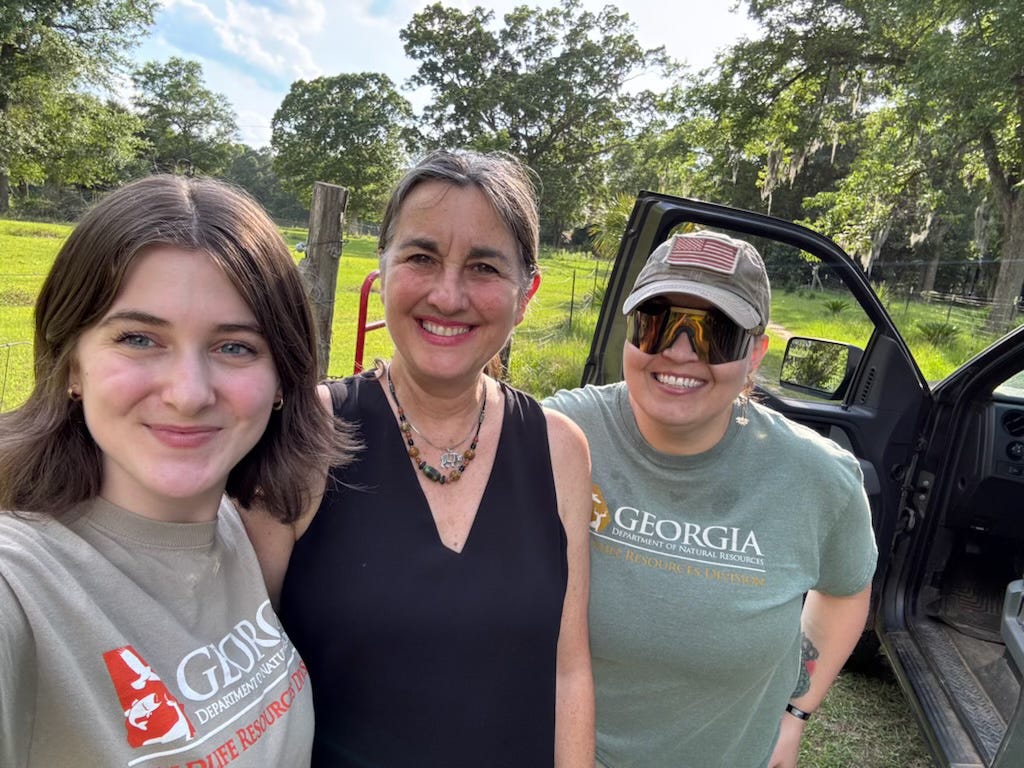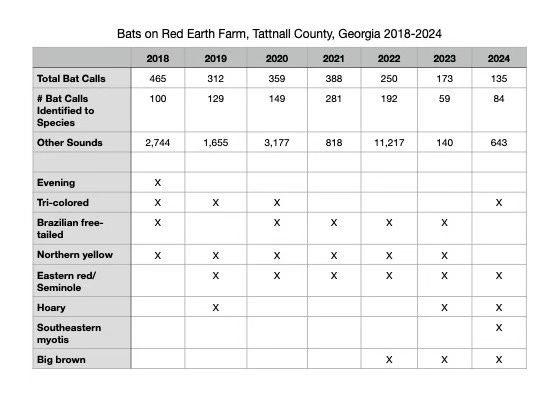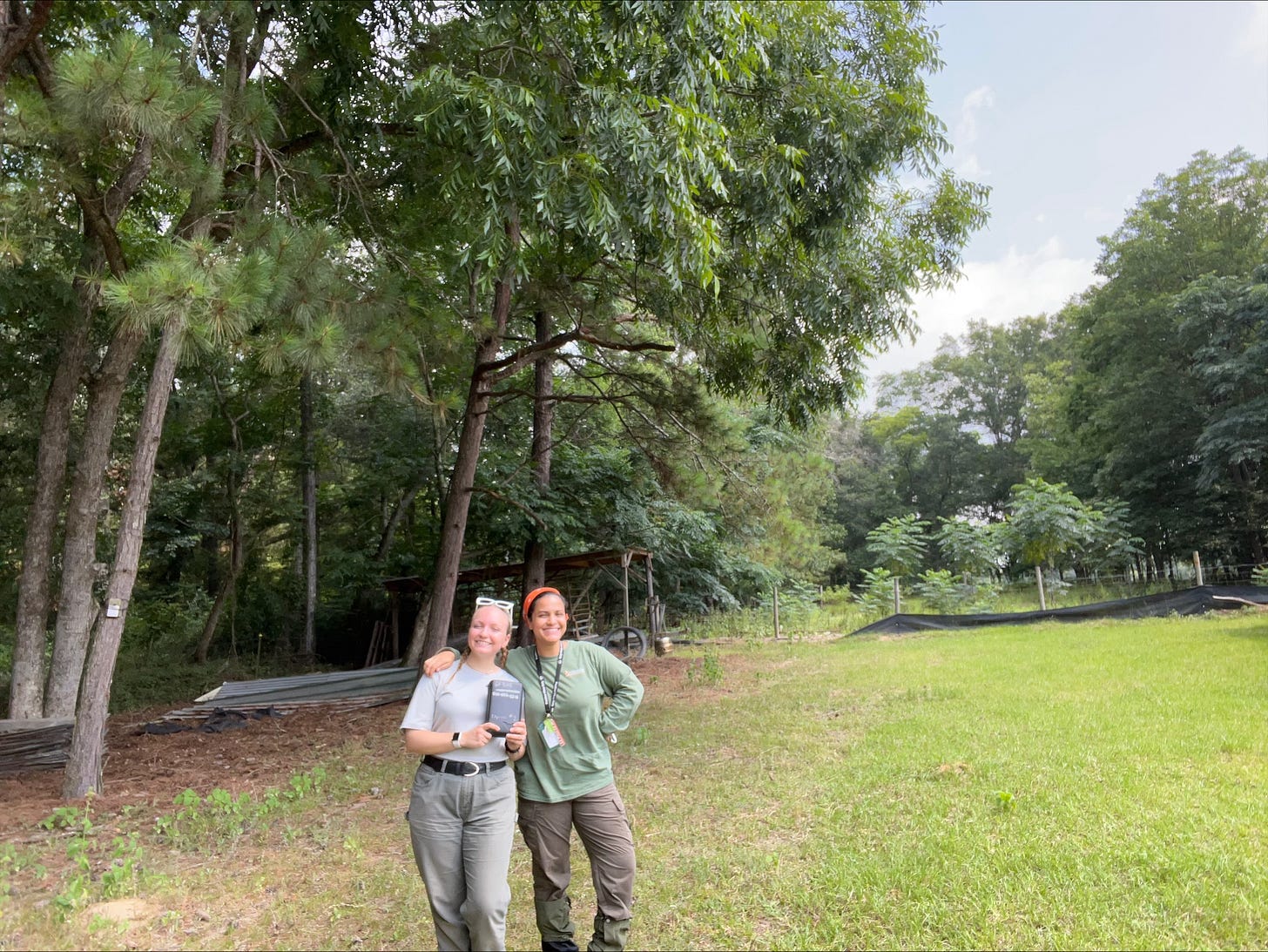FOR SEVEN YEARS our farm has been part of a vast North American bat study.
Every June technicians swing by and install an Anabat unit on a tree down near the woods. I usually manage to meet the technicians, who are different each summer, and all of them have been women, so I call them the batwomen. The batwomen slip in, closing gates fastidiously; they do their work; they depart quietly; and at the end of the week they tiptoe back to retrieve their equipment.

The unit records bat calls. Its recordings are fed into a computer program (Kaleidoscope Pro) that analyzes the call sequences. “This is used to determine the most likely bat that would produce each call sequence,” the Georgia Department of Natural Resources explains. “This means that there may be some errors in the results.”
Not only is the Anabat unit flawed at pinpointing exact species, it’s also not great at determining species abundance. Let’s say the Anabat records a hoary bat. The machine cannot accurately report how many hoaries live at the farm. One bat could be flying around the unit all night long, squeaking its head off.
The Anabat is impacted by
clutter of nearby vegetation
road sounds
electrical noise
weather
other wildlife.
“We don’t trust acoustic results 100%,” Emily Farrell, wildlife biologist, said to me. Researchers use acoustics to understand things like
activity periods throughout the night
species diversity (to some degree)
overall trends.
The data is submitted to the North American Bat Monitoring Program (NABat) run by the U.S. Geological Survey. The purpose of NABat is “to monitor bats at local to range-wide scales that will provide reliable data to promote effective conservation and long-term viability of bat populations across the continent.“
My family and I get to participate through our state’s DNR, which uses both public and private lands for the study. Every year we rip open the report from the batwomen. In 2018 it read like this.
2018 Results
June 11, 2018 to June 14, 2018
Total # of bat calls: 465
Calls identified to species: 100
At least one bat of the following species were identified with a 95% or more “confidence interval”:
evening bat
tri-colored bat
Brazilian free-tailed bat
northern yellow bat
Other sound files not identified as bats: 2,774
The biologists thought these “other sound files” were most likely insect calls. The guineas make weird noises at night as they’re roosting, and owls launch lines of cackles and howls and screeches out into darkness. Mockingbirds sometimes turn into night-birds. On spring, summer, and fall nights I hear crickets, cicadas, frogs of many species, and some deep eerie whale-like ringing that is probably the universe singing to itself.
Wildness is noisy.
Note on the Tri-colored Bat
This is a species of concern in Georgia currently under consideration for listing under the Endangered Act, so I’m particularly proud to have this one.
Note on the Northern Yellow Bat
Trina Morris, wildlife biologist with DNR, wrote to me that “This detection of a northern yellow bat so far away from the coast is unusual. We have historic records of this species in the upper coastal plain but haven’t captured any in this area recently. It is certainly possible that this species could be found on your property, but we cannot consider it a true record until it is verified by a hand capture.” That could be exciting.
Almost every night, when I go out in the golden light to feed the horses, I’ll see a bat or two careening overhead. My uncle used to call them “leatherwings.” From the ground they all look the same, so if I see a bat, I too call it a leatherwing. As usual I’ve become aware of how very little I know about everything, especially bats.
Who would have known that during the last seven years the following bats have been heard at Red Earth Farm.
Evening (Nycticeius humeralis)
Tri-colored (Perimyotis subflavus)
Northern yellow (Lasiurus intermedius)
Brazilian free-tailed (Tadarida brasiliensis)
Eastern red/ Seminole (Lasiurus borealis, Lasiurus seminolus) These two can’t be differentiated by calls.
Hoary (Lasiurus cinereus)
Southeastern myotis (Myotis austroriparius)
Big brown (Eptesicus fuscus)
In most years, four different bats were identified by sound. These last two years—2023 and 2024—five bats have been heard. The tri-colored, the endangered one, was present through 2020, after which it vanished for three years, but was back in 2024.
The number of “total sounds recorded” varied wildly year to year. One year the Anabat recorded an astonishing total of 11,217 sounds over 4 nights. Can you imagine trying to sleep in this forest?
Apparently 2023 was a very quiet and sober year because that number fell to 140.
I made a graph of the study results as they pertain to our farm. Here it is.
I see some disturbing trends.
A marked decline in bat calls.
A severe decline in total sounds on the farm.
The evening bat, identified from the first year, hasn’t been heard since.
I wrote Farrell.
“Has there been a change in the data-collecting equipment? 2023 seemed a particularly bad year for ‘other sounds,’ with only 140 collected.”
“Our detectors have not changed,” Emily replied, “but we do end up having to send them off annually for repairs and maintenance. It could be the microphone we used in 2023 at your home was in need of a tune-up. It is also possible other factors that week—such as rain—limited bat activity.”
About the decline in evening bats she said, “Evening bats have calls similar in frequency range to red bats, so it could be the software is not getting those species split out correctly.”
To give positive news its due, I noticed some uplifting trends.
The big brown wasn’t here, then it was.
The number of total sounds went back up in 2024.
We have bats! We still have bats!
Thanks
Thanks to biologists everywhere who are monitoring the wild beings of our planet. Thanks to Georgia DNR for choosing our farm as a study site. Thanks to Trina Morris, Emily Farrell, and all the batwomen over the years.
Aside
We received this email one year from one of the batwomen.
Thanks again for allowing us to come sample on your beautiful property! It didn’t seem like anyone was home when we stopped by, but we went ahead and collected the equipment.
Also, we weren’t sure if you already knew this but thought it might be worth mentioning—there was a brown horse down the road from your property that we’re pretty sure is yours! We weren’t sure if he/she was out intentionally or if they managed to escape somehow.
Thank you again and we look forward to processing the data to see what kinds of bats are your neighbors!
All the best, Cami
They were right. The horse belongs here. It’s a he. Our fencing is not always state-of-the-art.
Know What You Can Do to Help Bats?
Leave dead trees. (I’m curious to know if total bat sounds will rise following the destructive hurricanes of ‘24.)
Reduce lawn-mowing and leaf-raking. Give your yard over to a native habitat, for the purpose of safe-guarding the insects that bats eat.
Reduce herbicide & pesticide use to protect the food-source of bats, for the same reason.
Plant night-blooming native plants to attract insects.
Provide a water source, even something as simple as a trough.
Turn off night lights.
Keep cats indoors at dawn and dusk.
Way Down Here at the Bottom
OUR FARM HAS seemed particularly remote this week. I work at home. Plus everybody here has been sick with a cold, so we’re mostly staying indoors. The trash truck passes on Mondays, and that warrants an announcement. On Monday as well a delivery person bumbled in with a new case of formula.
We have banks of windows, and I’ve been standing at them, holding the baby over one shoulder while patting her back. A couple of days ago I was standing at a large windows staring out at the winter pastures, out toward the empty dirt road, and I thought: If this is my life—if this quiet place is my whole life—I should make it as full of beauty and life as I possibly can.
By that I mean that I should double down on planting the vines and flowers and trees that attract birds, insects, and all the other kingdoms.
If this is the place I’m going to live out my life, make it full. Fill in the blanks with living things.
What I’m Listening To
“Come Healing” by Leonard Cohen. The Live in Dublin version. This one.







What a wonderfully well-learned sharing! There are so many amazing things about these unique mammals. The Tricolored bats will always be 'pips' to me. They were eastern pipistrelles before they were reclassified into a different genus. They were once so abundant. Even with the old Pettersson detectors in the 90s, that only gave a frequency readout rather than a sonogram, we could tell when we had pips because they had two frequency peaks. It is disappointing that the Anabats, with all their innovation, still cannot distinguish some species, especially the Myotis genus, which encompasses so many of the endangered species of bats. I have known Trina for many years, even before that fateful day when an Indiana bat flew into Georgia on the heels of White-Nose Syndrome and the race to acquire critical bat conservation data in Georgia accelerated in earnest. Thanks for loving on our beloved Chiropterans...and all living beings! That Cohen song is beautiful. May it prove true for bats too. I have seen far too many leatherwings ravaged by WNS.
I love that moment of you standing at a large window with the baby over your shoulder, thinking that the rest of your life may be in this place. Beautiful!